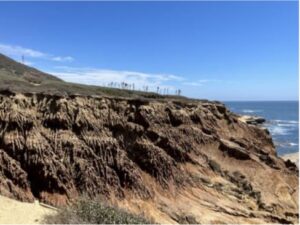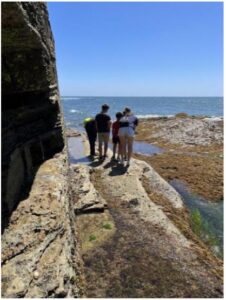Like many families, the pandemic kept us grounded in our home on the East coast and separated from family who live on the west coast. This summer, it was important for us to reconnect with those we had not been able to see for too many years. The excitement of finally boarding the plane and heading to San Diego, knowing so many loved ones awaited us when we landed, made the lengthy flight feel even longer. After a few days of enjoying time together, we needed to find some activities to do. However, it was a challenge to find something that would appeal to six kids from ages 8 to 19 (and parents, too!) As the kids grow and children become young adults, maintaining relationships among a wide age range is a vitally important but ever-increasing challenge. Finding shared experiences, I have found, helps bridge that divide.
The obvious solution for our family? A visit to San Diego’s national monument.
 The announcement of a visit to Cabrillo National Monument admittedly received multiple groans as we were piling into the car, and there were multiple questions about what was going to be so interesting about tide pools. However, after we arrived, everyone was captivated by the landscape that stretched before us. The rock formations elicited numerous comparisons to photos of the Martian landscape, and a dirt path was an open invitation for a foot race among cousins – along with some much-needed distance from parents.
The announcement of a visit to Cabrillo National Monument admittedly received multiple groans as we were piling into the car, and there were multiple questions about what was going to be so interesting about tide pools. However, after we arrived, everyone was captivated by the landscape that stretched before us. The rock formations elicited numerous comparisons to photos of the Martian landscape, and a dirt path was an open invitation for a foot race among cousins – along with some much-needed distance from parents.
 The lack of cell phone coverage on the cliffs by the Pacific ensured everyone was focused on our surroundings. As we scampered over the rocks, older cousins guided the younger ones across wet, slippery cliffs and were rewarded with glimpses of all sorts of sea life in the cracks and crevices throughout the cliffs. Our thanks to the knowledgeable NPS volunteer who helped us identify the various sea creatures and showed us where other interesting sea life could be found. No matter how old they were, shouts rang out when a new, bigger crab was discovered. And of course, no trip to a water source is ever complete without a rock skipping contest.
The lack of cell phone coverage on the cliffs by the Pacific ensured everyone was focused on our surroundings. As we scampered over the rocks, older cousins guided the younger ones across wet, slippery cliffs and were rewarded with glimpses of all sorts of sea life in the cracks and crevices throughout the cliffs. Our thanks to the knowledgeable NPS volunteer who helped us identify the various sea creatures and showed us where other interesting sea life could be found. No matter how old they were, shouts rang out when a new, bigger crab was discovered. And of course, no trip to a water source is ever complete without a rock skipping contest.
 Learning about Cabrillo National Monument provided another example of how truth is stranger than fiction as we read about the feud between San Diego and Oakland and the “plundering” of the statue of Juan Rodriguez Cabrillo. As a history buff, sharing these odd historical anecdotes gives me hope I can instill an interest and love of history in my children too.
Learning about Cabrillo National Monument provided another example of how truth is stranger than fiction as we read about the feud between San Diego and Oakland and the “plundering” of the statue of Juan Rodriguez Cabrillo. As a history buff, sharing these odd historical anecdotes gives me hope I can instill an interest and love of history in my children too.
 The most poignant part of our visit was watching the U.S.S. Mobile Bay returning to San Diego Bay. As the ship came close, we stared in awe at the sailors lining the deck. We were fortunate that a member of the Navy’s public affairs team was also there photographing the experience, and we were humbled by the stories she was able to share of the ship’s deployment, as well as her own experiences of being deployed overseas.
The most poignant part of our visit was watching the U.S.S. Mobile Bay returning to San Diego Bay. As the ship came close, we stared in awe at the sailors lining the deck. We were fortunate that a member of the Navy’s public affairs team was also there photographing the experience, and we were humbled by the stories she was able to share of the ship’s deployment, as well as her own experiences of being deployed overseas.
Cabrillo was designated as a national monument in 1913 by President Wilson at the request of a local civic organization seeking to reconnect California with its Spanish heritage. The site languished under the control of the War Department and its care and management remained a challenge even after being transferred to the National Park Service. However, it remains a beautiful example of how local support led the way in the protection of a special site that continues to connect its visitors with the natural wonders of the environment and the community.
Our visit to Cabrillo National Monument is now a treasured memory and I’m so thankful for its existence. There are numerous landscapes and sites throughout our country – with strong local and community support – in need of additional protections, including sites such as Avi Kwa Ame and Castner Range. I hope that the administration will act swiftly and designate these sites as national monuments, ensuring they are protected for all to enjoy.
